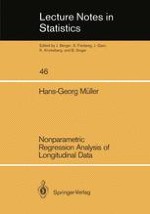1988 | OriginalPaper | Chapter
Longitudinal Data and Regression Models
Author : Hans-Georg Müller
Published in: Nonparametric Regression Analysis of Longitudinal Data
Publisher: Springer New York
Included in: Professional Book Archive
Activate our intelligent search to find suitable subject content or patents.
Select sections of text to find matching patents with Artificial Intelligence. powered by
Select sections of text to find additional relevant content using AI-assisted search. powered by
There exist several kinds of longitudinal data, i.e., measurements (observations) of the same quantity (occurrence) on the same subject at different time points, each of which requires different methods for analysis. We will be concerned with time course data, i.e. quantitative measurements as they are of interest in growth processes, physiological processes and in the assessment of the time course of a disease by means of laboratory parameters. Other longitudinal data which are sometimes of interest are event data like the timing of deaths, allograft rejections, or heart attacks, which usually are analysed by applying statistical methods for point processes and survival analysis. Other longitudinal biomedical data are the so-called biosignals EEG (electroencephalogram) and ECG (electrocardiogram). For the analysis of the EEG one can adopt methods from time series analysis, whereas the ECG mainly poses classification and discrimination problems. The appropriate methods for time course data are regression or time series models. If samples of time courses are studied, a classical approach are socalled growth curves which basically consist of multivariate analysis of variance techniques (see e.g. Goldstein, 1986). Our approach here, however, is different: We estimate individual time courses on the basis of a (parametric or nonparametric) regression model and use specific features of these individual estimates to draw inferences about samples.
